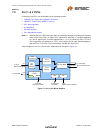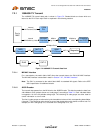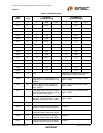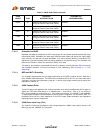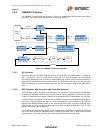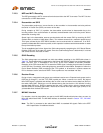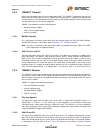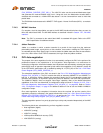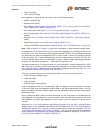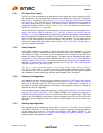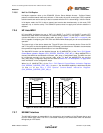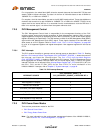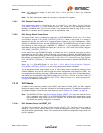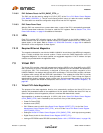
Two Port 10/100 Managed Ethernet Switch with 16-Bit Non-PCI CPU Interface
Datasheet
Revision 1.4 (08-19-08) 90 SMSC LAN9311/LAN9311i
DATASHEET
(PHY_SPECIAL_CONTROL_STAT_IND_x). The 10M PLL locks onto the received Manchester signal
and generates the received 20MHz clock from it. Using this clock, the Manchester encoded data is
extracted and converted to a 10MHz NRZI data stream. It is then converted from serial to 4-bit wide
parallel data.
The RX10M block also detects valid 10BASE-T IDLE signals - Normal Link Pulses (NLPs) - to maintain
the link.
7.2.4.3 MII MAC Interface
For reception, the 4-bit data nibbles are sent to the MII MAC Interface block where they are sent via
MII to the switch fabric MAC. The MII MAC Interface is described in detail in Section 7.2.7, "MII MAC
Interface".
Note: The PHY is connected to the switch fabric MAC via standard MII signals. Refer to the IEEE
802.3 specification for additional details.
7.2.4.4 Jabber Detection
Jabber is a condition in which a station transmits for a period of time longer than the maximum
permissible packet length, usually due to a fault condition, that results in holding the TXEN input for
an extended period of time. Special logic is used to detect the jabber state and abort the transmission
to the line, within 45ms. Once TXEN is deasserted, the logic resets the jabber condition.
7.2.5 PHY Auto-negotiation
The purpose of the auto-negotiation function is to automatically configure the PHY to the optimum link
parameters based on the capabilities of its link partner. Auto-negotiation is a mechanism for
exchanging configuration information between two link-partners and automatically selecting the highest
performance mode of operation supported by both sides. Auto-negotiation is fully defined in clause 28
of the IEEE 802.3 specification and is enabled by setting bit 12 (PHY_AN) of the Port x PHY Basic
Control Register (PHY_BASIC_CONTROL_x).
The advertised capabilities of the PHY are stored in the Port x PHY Auto-Negotiation Advertisement
Register (PHY_AN_ADV_x). The PHY contains the ability to advertise 100BASE-TX and 10BASE-T in
both full or half-duplex modes. Besides the connection speed, the PHY can advertise remote fault
indication and symmetric or asymmetric pause flow control as defined in the IEEE 802.3 specification.
The LAN9311/LAN9311i does not support “Next Page” capability. Many of the default advertised
capabilities of the PHY are determined via configuration straps as shown in Section 14.4.2.5, "Port x
PHY Auto-Negotiation Advertisement Register (PHY_AN_ADV_x)," on page 295. Refer to Section
4.2.4, "Configuration Straps," on page 40 for additional details on how to use the LAN9311/LAN9311i
configuration straps.
Once auto-negotiation has completed, information about the resolved link and the results of the
negotiation process are reflected in the speed indication bits in the Port x PHY Special Control/Status
Register (PHY_SPECIAL_CONTROL_STATUS_x), as well as the Port x PHY Auto-Negotiation Link
Partner Base Page Ability Register (PHY_AN_LP_BASE_ABILITY_x).
The auto-negotiation protocol is a purely physical layer activity and proceeds independently of the MAC
controller.
The following blocks are activated during an Auto-negotiation session:
Auto-negotiation (digital)
100M ADC (analog)
100M PLL (analog)
100M equalizer/BLW/clock recovery (DSP)
10M SQUELCH (analog)




